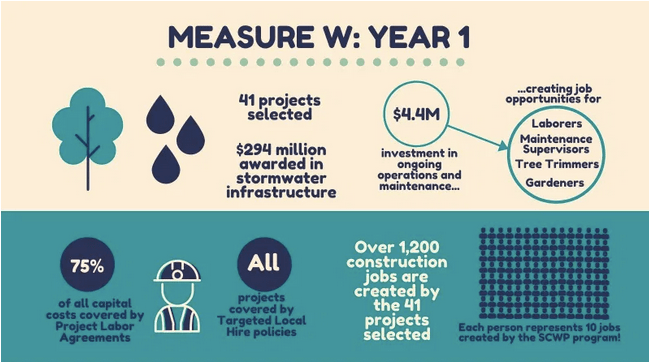Last week the Los Angeles County Board of Supervisors approved $95.3 million for the first year of funding for the Safe, Clean Water Program's regional program. The money will be used to fund 41 infrastructure projects, 16 technical resources projects, 4 scientific studies, and 12 Watershed Coordinators.
The San Gabriel Valley will receive more than $25.1 million this cycle, which will fund 9 infrastructure projects, 2 scientific studies, and 12 technical studies.
“After years of study and community engagement and project development, we're finally going to see the fruits of our labor,” said Hilda Solis, District 1 supervisor.
The ideas for the projects, personnel, and studies funded were developed and recommended by nine steering committees representing watershed areas throughout the county. Each area has compiled a Regional Program Stormwater Investment Plan which includes infrastructure, technical resources and scientific studies. The nine SIPs will receive $378.9 million over the next 5 years. Of the $358.1 million budgeted for infrastructure projects, $320 million will be invested in disadvantaged communities.
The board also directed Public Works staff to hire 12 watershed coordinators with a budget of $2.3 million annually for the next three years.
The Safe Clean Water Program, or Measure W, is a parcel tax that provides local, dedicated funding for rainwater and urban runoff management to increase the region's local water supply, improve water quality, and protect public health. The regional program makes up half of the Safe Clean Water Program's budget, which is estimated to generate $285 million per year.
Because the project list is pretty extensive, below are highlights of the projects that will receive the most money for this first cycle:
- East Los Angeles Sustainable Median Stormwater Capture Project ($7 million) - Los Angeles County
- Garvey Avenue Grade Separation Drainage Improvement Project ($4 million) - city of El Monte
- Located in El Monte, development over the last 85 years development has increased stormwater runoff and flooding, specifically at Garvey Avenue's grade separation sump. This project proposes a new storm drain and infiltration system to alleviate the flooding. The proposed storm drain improvements are located south of the 10 Freeway and the general alignment is southeast along Maxson Place, then across Garvey Avenue running through an easement on private property to the existing storm drain system at Durfee Avenue. The project is expected to receive more than $13.5 million over the next 5 years.
- Bassett High School Stormwater Capture Multi-Benefit Project ($3 million) - Los Angeles County
- This project is expected to receive more than $31 million over the next 5 years. The project would create a regional, multi-benefit, stormwater capture project at Bassett High School in the city of La Puente.
- Adventure Park Multi-Benefit Stormwater Capture Project ($2 million) - Los Angeles County Public Works
- This multi-benefit project is located at Adventure Park in the unincorporated county area of South Whittier. The project will collect up to 50 cubic feet per second of runoff from Sorenson Drain, and convey it to a pretreatment system and 19.5-acre foot of underground storage, and sending some to the sewer system for treatment and reuse. The project will also include recreational features: athletic fields, trees, and bioswales planted with native species. The project is expected to receive more than $13.5 million over the next 5 years.
For a full list of the approved regional projects, click here; for a full list of SGV projects, click here.
Advocates such as Los Angeles Alliance for a New Economy, Our Water L.A. and Nature for All lauded the passed budget. But, in an Our Water L.A. blog post, the group still says there's work to be done:
We’re proud to continue to play a role in informing and guiding the Safe Clean Water Program. Still, we know that for the program to live up to its full promise, it must be accountable to and follow the lead of communities who are striving for clean water and healthy communities for all, including these ongoing priorities:
- Nature-Based Solutions: The program needs to prioritize investments in projects that provide multiple benefits for communities, including projects that include climate adaptation and mitigation in their design and implementation and that foster community stewardship of local projects.
- Community-Led Project Design: The program overall and all steering committees need to sustain community engagement throughout all projects’ development, implementation, operation, and maintaining.
- Metrics for Community Investments: The program needs more metrics and transparent processes to achieve its goals and community benefits.
- Jobs: The program needs to promote green jobs and career pathways with an emphasis on local hire and good paying jobs. The program should support local hiring for the equitable distribution of funds and to help foster a sense of community pride and stewardship for local projects. Workforce development pipelines and programs should be established to connect communities to job opportunities.
For more details, see also the L.A. County Staff Report (SCWP Budget-SGV Projects) and L.A. County Staff Report (SCWP Budget)
SBLA San Gabriel Valley coverage, including this article and SGV Connect, is supported by Foothill Transit, offering car-free travel throughout the San Gabriel Valley with connections to the new Gold Line Stations across the Foothills and Commuter Express lines traveling into the heart of downtown L.A. To plan your trip, visit Foothill Transit. “Foothill Transit. Going Good Places.”
Sign-up for our SGV Connect Newsletter, coming to your inbox on Fridays






